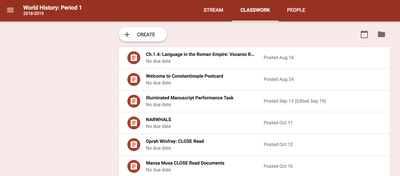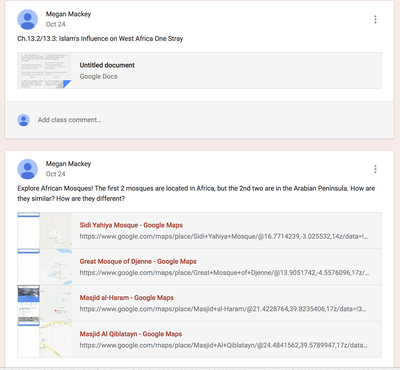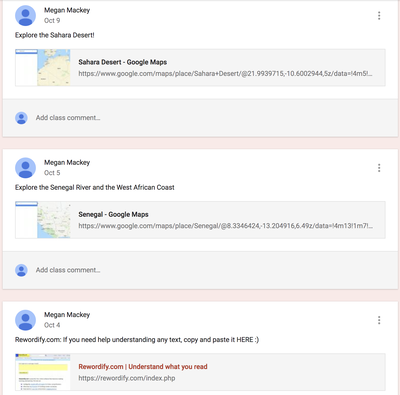Your browser does not support viewing this document. Click here to download the document.
| cstp1_mackey_09.21.17.pdf | |
| File Size: | 106 kb |
| File Type: | |
1.1 Using knowledge of students to engage them in learning
Level of Development: Integrating/Innovating: Students actively utilize a variety of instructional strategies and technologies in learning that ensure equitable access to the curriculum. Uses comprehensive knowledge of students to make ongoing adjustments and accommodations in instruction.
Date: 9/26/17
Evidence: Documentation: I document focus students’ strengths, interests, needs and use this information to inform planning and instruction as part of my weekly data reflections; I also identify and build on existing areas of student competence. See file below from the week of October 6th. Student names have been redacted.
Level of Development: Integrating/Innovating: Students actively utilize a variety of instructional strategies and technologies in learning that ensure equitable access to the curriculum. Uses comprehensive knowledge of students to make ongoing adjustments and accommodations in instruction.
Date: 9/26/17
Evidence: Documentation: I document focus students’ strengths, interests, needs and use this information to inform planning and instruction as part of my weekly data reflections; I also identify and build on existing areas of student competence. See file below from the week of October 6th. Student names have been redacted.
| copy_of_10-9_mackey_vista_heritage_weekly_data_reflection.docx.pdf | |
| File Size: | 193 kb |
| File Type: | |
1.2 Connecting learning to students’ prior knowledge, backgrounds, life experiences, and interests
Level of Development: Applying: Uses school resources and family contacts to expand understanding of students’ prior knowledge, cultural backgrounds, life experiences, and interests to connect to student learning. Students make connections between curriculum, and their prior knowledge, backgrounds, life experiences, and interests.
Date: 9/26/17
Evidence: Students are allowed some choices in learning activities to align with personal interests. For example, students will prepare a slideshow based on an artifact from either medieval West African or Imperial China (Han-Yuan Dynasties). I provided students with links to museum websites featuring such artifacts, but students are allowed to choose one that interests them as they will link it to the historical themes we are covering this year. Below are the directions and scoring rubric for this project:
Level of Development: Applying: Uses school resources and family contacts to expand understanding of students’ prior knowledge, cultural backgrounds, life experiences, and interests to connect to student learning. Students make connections between curriculum, and their prior knowledge, backgrounds, life experiences, and interests.
Date: 9/26/17
Evidence: Students are allowed some choices in learning activities to align with personal interests. For example, students will prepare a slideshow based on an artifact from either medieval West African or Imperial China (Han-Yuan Dynasties). I provided students with links to museum websites featuring such artifacts, but students are allowed to choose one that interests them as they will link it to the historical themes we are covering this year. Below are the directions and scoring rubric for this project:
| artifact_sources_.pdf | |
| File Size: | 132 kb |
| File Type: | |
| mackey_quarter_2_rubric_-_1_performance_task-2.pdf | |
| File Size: | 105 kb |
| File Type: | |
1.3 Connecting subject matter to meaningful, real-life contexts
Level of Development: Applying/Integrating: Integrates connections to meaningful, real-life contexts in planning subject matter instruction and is responsive during instruction to engage students in relating to subject matter. Students utilize real-life connections regularly to develop understandings of subject matter.
Date: 9/26/17
Evidence: World history is all about making real-life connections between the past and present. Recently we completed a lesson about the legacy of West African visual and musical arts. We looked at many modern examples of this legacy including the works of Pablo Picasso and several links to videos about music today influenced by West Africa. Below is the PDF of student classroom notes and some links to the videos we viewed in class. *Note:* Students did not watch entire videos in class, but rather 30 second clips and were asked to make observation notes, participate in classroom discussion, and find the beat to clap along in each piece.
Youtube Links:
SHOUT! - Isley Brothers
Gospel Music
Blue-Grass
Afro-Cubano Drumming
Street Drum Corp
| ch.14.2-14.3_reading_notes_.pdf | |
| File Size: | 75 kb |
| File Type: | |
1.5 Promoting critical thinking through inquiry, problem solving, and reflection
Level of Development: Exploring: Includes questions in single lessons or a sequence of lessons that require students to recall, interpret, and think critically. Students respond to varied questions or tasks designed to promote comprehension and critical thinking in single lessons or a sequence of lessons.
Date: 9/26/17
Evidence: Students recently completed a primary and secondary source evaluation based on an Islamic West African king, Mansa Musa. The 3 day lesson was completed during our Medieval West Africa unit and draws from our Medieval Islam unit. Students were asked the question: Was Mansa Musa the richest person ever? We opened the lesson brainstorming the wealthiest people alive today, before evaluating 3 sources; 1 secondary and 2 primary sources. Students were asked at the end of each source to evaluate its reliability by using the frame "I think/ I don't think this source is trustworthy because..." At the end of the lesson students chose which source they thought was most reliable and gave evidence to support their opinion. This lesson was adapted from SHEG to fit with student needs. Below is the PDF of the student handout and the notes we completed to help students learn to CLOSE read documents.
Level of Development: Exploring: Includes questions in single lessons or a sequence of lessons that require students to recall, interpret, and think critically. Students respond to varied questions or tasks designed to promote comprehension and critical thinking in single lessons or a sequence of lessons.
Date: 9/26/17
Evidence: Students recently completed a primary and secondary source evaluation based on an Islamic West African king, Mansa Musa. The 3 day lesson was completed during our Medieval West Africa unit and draws from our Medieval Islam unit. Students were asked the question: Was Mansa Musa the richest person ever? We opened the lesson brainstorming the wealthiest people alive today, before evaluating 3 sources; 1 secondary and 2 primary sources. Students were asked at the end of each source to evaluate its reliability by using the frame "I think/ I don't think this source is trustworthy because..." At the end of the lesson students chose which source they thought was most reliable and gave evidence to support their opinion. This lesson was adapted from SHEG to fit with student needs. Below is the PDF of the student handout and the notes we completed to help students learn to CLOSE read documents.
| mansa_musa_close_read_student_questions_.pdf | |
| File Size: | 25 kb |
| File Type: | |
| annotation_notes.pdf | |
| File Size: | 28 kb |
| File Type: | |
Technology Emphasis
CSTP 1.2: Connecting learning to students’ prior knowledge, backgrounds, life experiences, and interests
Rating: Applying- Uses school resources and family contacts to expand understanding of students’ prior knowledge, cultural backgrounds, life experiences, and interests to connect to student learning. Students make connections between curriculum, and their prior knowledge, backgrounds, life experiences, and interests.
Evidence: I have been using some technology aspects in addition paper-based projects to get to know my students. One of my first projects of the year was for students to create a CLIPS presentation about their summer vacation.
Talking Points
Rating: Applying- Uses school resources and family contacts to expand understanding of students’ prior knowledge, cultural backgrounds, life experiences, and interests to connect to student learning. Students make connections between curriculum, and their prior knowledge, backgrounds, life experiences, and interests.
Evidence: I have been using some technology aspects in addition paper-based projects to get to know my students. One of my first projects of the year was for students to create a CLIPS presentation about their summer vacation.
Talking Points
|
CSTP 1.2: Connecting learning to students’ prior knowledge, backgrounds, life experiences, and interests
Rating: Applying- Uses school resources and family contacts to expand understanding of students’ prior knowledge, cultural backgrounds, life experiences, and interests to connect to student learning. Students make connections between curriculum, and their prior knowledge, backgrounds, life experiences, and interests. Evidence: I have been using some technology aspects in addition paper-based projects to get to know my students. One of my first projects of the year was for students to create a CLIPS presentation about their summer vacation. |
Your browser does not support viewing this document. Click here to download the document.
|
|
Your browser does not support viewing this document. Click here to download the document.
|
CSTP 1.3 Connecting subject matter to meaningful, real-life contexts
Rating: Applying- Integrates connections from subject matter to meaningful, real-life contexts, including those specific to students’ family and community. Evidence: In the last week student have conducted a CLOSE Read about Mansa Musa, a Mali emperor from the 14th century. Although the information covered in the documents does not relate to real life matters (unless you want to know who the richest person in history is), we used the documents as a way to practice detecting fake new or unreliable sources. As a class we participated in discussion about fake news and what may come of it. We then used a variety of CLOSE reading strategies to determine which source was the most reliable and why. Students were asked to conduct research on the website in which the sources came from, in addition to determining reliability in a social studies context. |
|
1.4 Using a variety of instructional strategies, resources, and technologies to meet students’ diverse learning needs
Rating: Exploring- Explores additional instructional strategies, resources, and technologies in single lessons or sequence of lessons to meet students’ diverse learning needs. Evidence: I use a variety of instructional strategies in my classroom, but am focusing on integrating a variety of technology strategies as well. My goal is to transform learning with technology, rather than substituting technology in place of non-tech resources. I've included a slideshow of my Google Classroom stream. |
Here are some addition technology resources I have posted to Google Classroom:
Mindfulness for Students Rewordify Vocaroo Voice Recording |
NBTps and TLMS INCORPORATION
CSTP 1.2: Connecting learning to students’ prior knowledge, backgrounds, life experiences, and interests
CSTP 1.3: Connecting subject matter to meaningful, real-life contexts.
NBPTS Proposition 1: Teachers are committed to students and their learning. Point 1: Teachers Recognize Individual Differences in Their Students and Adjust Their Practice Accordingly
TLMS Domain 1d: Strives to create an inclusive culture where diverse perspectives are welcomed in addressing challenges.
Evidence: All students learn differently, have different strengths, and areas of need. In my curriculum this year I have been integrating much more student choice.
Students recently completed a project based around the Reformation. We studied the Reformation as a case study to teach them to be activists on a modern issue of their choice. Students chose an issue to act on and were asked to create a pamphlet or flyer calling the public to action. This project was designed to give students choice and agency over their work. It was also easily scaled to help students learning reading/writing fundamentals to students reading and writing above grade level.
This year I have been working to create an inclusive environment for all students. 7th grade has the highest caseload in our inclusive special education setting. For this reason it is even more important to create an environment in which all students can achieve.
CSTP 1.3: Connecting subject matter to meaningful, real-life contexts.
NBPTS Proposition 1: Teachers are committed to students and their learning. Point 1: Teachers Recognize Individual Differences in Their Students and Adjust Their Practice Accordingly
TLMS Domain 1d: Strives to create an inclusive culture where diverse perspectives are welcomed in addressing challenges.
Evidence: All students learn differently, have different strengths, and areas of need. In my curriculum this year I have been integrating much more student choice.
Students recently completed a project based around the Reformation. We studied the Reformation as a case study to teach them to be activists on a modern issue of their choice. Students chose an issue to act on and were asked to create a pamphlet or flyer calling the public to action. This project was designed to give students choice and agency over their work. It was also easily scaled to help students learning reading/writing fundamentals to students reading and writing above grade level.
This year I have been working to create an inclusive environment for all students. 7th grade has the highest caseload in our inclusive special education setting. For this reason it is even more important to create an environment in which all students can achieve.
|
Your browser does not support viewing this document. Click here to download the document.
Attached are the instructions for the Reform It Pamphlet Project students completed while learning about the Protestant Reformation. I have also attached the Drafting Guide that coached students though the writing process, both individually and in small group. This project was designed to meet the needs of all students. In my class I have a wide range of students from English Learners, IEP, to GATE. Reaching all student can needs can be a challenge. Student choice in topic is key. I had some students write about pizza in the cafeteria, while other wrote about immigration laws in the US. I also gave students the opportunity to teach each other, especially my students in need of additional challenges.
|
To the left is a list of ideas taken from a Nearpod Collaborate activity. Students were asked to think of elements in the school, the US, and the world that need to be reformed or changed. I took these ideas and combined them onto one paper for student reference during their project. Activating student prior knowledge was key to starting our project.
Your browser does not support viewing this document. Click here to download the document.
Your browser does not support viewing this document. Click here to download the document.
| ||||||


